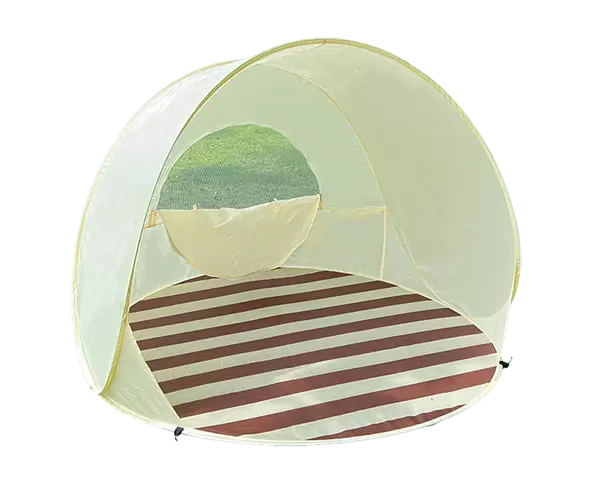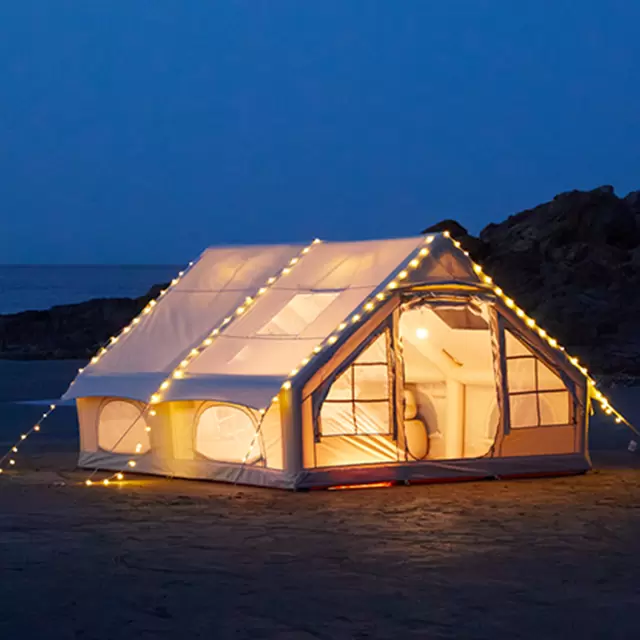When planning a camping trip, few things can ruin your outdoor adventure faster than waking up in a soggy sleeping bag. Rain is often unpredictable, and having a waterproof tent is essential for staying dry and comfortable. However, many campers are confused by the term "waterproof" and the numbers that appear on tent specifications as "2000mm" or "5000mm." What do these ratings actually mean? How waterproof is your tent really? In this article, we'll break down tent waterproof ratings, explain how they're measured, and help you understand how to choose the right level of waterproof protection for your camping needs.
1. What Does "Waterproof" Actually Mean for a Tent?
A tent being labeled as "waterproof" doesn't mean it's completely impervious to water in every situation. In fact, no fabric is 100% waterproof under all conditions. The term "waterproof" refers to a tent's ability to resist water penetration under specific laboratory tests and real-world conditions.
Tents are made from materials like nylon or polyester, which are then coated with a waterproof layer such as polyurethane (PU) or silicone. This coating creates a barrier that prevents water from seeping through the fabric. However, over time, UV exposure, dirt, and physical wear can degrade this coating, reducing its effectiveness.
Therefore, a tent's "waterproof" status depends on:
The type of coating or laminate used.
The hydrostatic head rating (measured in millimeters).
The construction quality, such as seam sealing and zipper design.
The tent's maintenance and age.
2. Understanding Hydrostatic Head (HH) – The Core of Waterproof Ratings
The hydrostatic head (HH) is the most common way to measure a tent's waterproof rating. It determines how much water pressure the fabric can withstand before it starts to leak.
Here's how it works:
In a laboratory test, a column of water is placed on top of the tent fabric. The height of the water column (measured in millimeters) at the point where water begins to seep through the fabric is the HH rating.
For example:
A 2000mm rating means the fabric can resist the pressure of a 2-meter (2000mm) column of water before leaking.
A 5000mm rating means it can withstand a 5-meter column of water.
The higher the number, the more waterproof the fabric.

3. Common Tent Waterproof Ratings and What They Mean
Let's break down the common waterproof ratings and what kind of weather conditions they are suitable for:
| Hydrostatic Head Rating | Waterproof Level | Suitable Conditions |
|---|---|---|
| 800mm – 1000mm | Water-resistant | Light rain or drizzle. Minimal protection for fair-weather camping. |
| 1500mm – 2000mm | Standard waterproof | Good for most summer camping trips, handles light to moderate rain. |
| 3000mm – 4000mm | High waterproof | Suitable for heavy rain and longer trips in wet climates. |
| 5000mm+ | Extreme waterproof | Ideal for alpine or tropical conditions, handles heavy rain and strong winds. |
For most campers, a tent with a 2000–3000mm rating on the flysheet and a floor rating of 3000–5000mm is more than sufficient. The floor rating is usually higher because it must resist pressure from people sitting or lying on it.
4. Tent Components That Affect Waterproof Performance
While the fabric rating is essential, other tent components also determine how waterproof your shelter will actually be.
(1) The Rainfly
The rainfly is the outer layer of your tent that covers the inner mesh or fabric. It's your first line of defense against rain. A full-coverage rainfly with sealed seams and a high waterproof rating (2000mm or more) provides the best protection.
(2) The Tent Floor
The floor is subjected to more pressure than the walls, as your body weight pushes moisture upward from the ground. Therefore, most tent floors have higher HH ratings and are often made of polyethylene or heavy-duty nylon with welded corners to prevent leaks.
(3) The Seams
Even the most waterproof fabric can leak if the seams aren’t sealed properly. Look for tents with taped or heat-sealed seams, which prevent water from entering through stitching holes.
(4) The Zippers
Zippers are weak points where rain can easily sneak in. High-quality tents often feature storm flaps-fabric covers that protect zippers from direct exposure to rain.
(5) The Tent Design
Dome-shaped or geodesic designs tend to shed rainwater more effectively than flat-roofed tents. Proper rainfly coverage, tensioned guy lines, and an elevated bathtub-style floor all contribute to keeping water out.
5. Waterproof Coatings and Materials Explained
Different waterproof coatings provide varying levels of durability and water resistance.
Polyurethane (PU) Coating:
The most common waterproof layer. It's cost-effective but can degrade over time, especially under UV light.Silicone (Sil) Coating:
Found on high-end tents, silicone offers superior water resistance, UV protection, and fabric flexibility. However, it's more expensive and harder to seam seal.Silnylon:
A blend of silicone-coated nylon. It's lightweight, durable, and often used in backpacking tents.Polyester with PU Coating:
Common in family and budget tents. It offers a good balance of cost, waterproofing, and UV resistance.
6. Real-World Factors That Influence Tent Waterproofness
Even with a high waterproof rating, a tent can still leak under certain conditions. Here are some real-world factors that can affect waterproof performance:
(1) Pressure and Touch
When you press against a wet tent wall from the inside, your body weight can push water through the fabric-especially if the rating is low.
(2) Prolonged Rain
Continuous heavy rain can eventually penetrate lower-rated fabrics, especially if the seams are not sealed or the fabric is old.
(3) Wind
Strong winds drive rain at an angle, putting more pressure on the seams and rainfly, which can increase leakage risks.
(4) Condensation
Sometimes what you think is a leak is actually condensation forming inside the tent due to poor ventilation. Good airflow helps reduce moisture buildup.
(5) Age and Maintenance
Dirt, sun exposure, and abrasion gradually wear down waterproof coatings. Regular cleaning, re-coating, and proper storage extend your tent's life.
7. How to Maintain and Improve Tent Waterproofing
Proper care can significantly improve your tent's performance and longevity. Here are key maintenance tips:
Clean your tent regularly: Use mild soap and water-never detergents that can damage waterproof coatings.
Dry completely before storing: Moisture promotes mold growth and coating degradation.
Re-seal seams annually: Apply seam sealer to reinforce critical areas.
Re-coat the fabric: Use waterproofing spray or PU/silicone treatment to refresh the outer layer.
Store properly: Keep your tent in a cool, dry place, loosely packed to prevent material stress.
8. Choosing the Right Waterproof Tent for Your Needs
Your ideal waterproof rating depends on where and how you camp:
Casual summer camping: 1500–2000mm flysheet and 3000mm floor are sufficient.
Mountain or rainy regions: 3000–5000mm flysheet and 5000mm+ floor.
Expeditions or alpine use: 5000mm+ for both flysheet and floor with double-wall construction.
Backpacking: Balance weight and waterproofness-silnylon or silpoly tents are ideal.
9. Testing Your Tent's Waterproofness at Home
Before heading out, it's wise to test your tent:
Pitch it in your backyard.
Spray it with a garden hose or simulate rain.
Inspect seams and corners for leaks.
Check the floor by pouring a small amount of water and pressing gently to see if it seeps through.
If you find any weak points, reapply waterproof spray or seam sealer before your trip.
10. Conclusion: Know Your Tent's Limits
Understanding your tent's waterproof rating helps you make informed decisions and avoid unpleasant surprises during your trip. Remember:
Waterproof ratings (measured in mm) tell you how much rain a tent can handle, but construction quality, maintenance, and design are equally important.
A tent with 2000–3000mm waterproofing, sealed seams, and a durable rainfly is more than enough for most conditions.
Regular upkeep ensures that your tent remains a reliable shelter for years to come.
In the end, a waterproof tent isn't just about numbers-it's about preparedness. Knowing your tent's capabilities gives you confidence to face any storm, ensuring that your camping adventure remains dry, safe, and enjoyable












